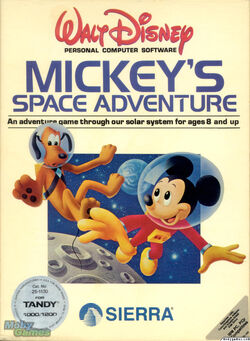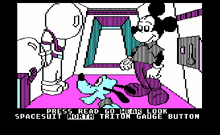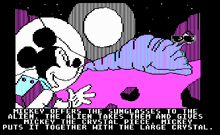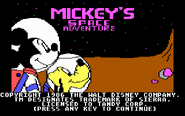No edit summary |
No edit summary |
||
| Line 1: | Line 1: | ||
| + | |||
[[File:Mickey's_space_adventure.jpg|thumb|250px]] |
[[File:Mickey's_space_adventure.jpg|thumb|250px]] |
||
'''''Mickey's Space Adventure''''' is a graphic adventure computer game for a number of computer platforms. It was created by Al Lowe and released by Sierra Entertainment in 1984. It features the [[The Walt Disney Company|Disney]] characters [[Mickey Mouse]] and [[Pluto (Disney)|Pluto]], with an optional cameo by [[Minnie Mouse|Minnie]]. It was the first computer game to feature Mickey Mouse, and the first videogame to feature Mickey Mouse beyond LCD Game and Watch games, predating his console debut in [[Mickey Mousecapade]]. |
'''''Mickey's Space Adventure''''' is a graphic adventure computer game for a number of computer platforms. It was created by Al Lowe and released by Sierra Entertainment in 1984. It features the [[The Walt Disney Company|Disney]] characters [[Mickey Mouse]] and [[Pluto (Disney)|Pluto]], with an optional cameo by [[Minnie Mouse|Minnie]]. It was the first computer game to feature Mickey Mouse, and the first videogame to feature Mickey Mouse beyond LCD Game and Watch games, predating his console debut in [[Mickey Mousecapade]]. |
||
| Line 36: | Line 37: | ||
<gallery> |
<gallery> |
||
Mickeyspace1.gif |
Mickeyspace1.gif |
||
| + | 7045-MickeysSpaceAdventure.jpg |
||
</gallery> |
</gallery> |
||
Revision as of 21:04, 12 August 2018

Mickey's Space Adventure is a graphic adventure computer game for a number of computer platforms. It was created by Al Lowe and released by Sierra Entertainment in 1984. It features the Disney characters Mickey Mouse and Pluto, with an optional cameo by Minnie. It was the first computer game to feature Mickey Mouse, and the first videogame to feature Mickey Mouse beyond LCD Game and Watch games, predating his console debut in Mickey Mousecapade.
Plot
While out walking Pluto, Mickey Mouse stumbles upon a spaceship. Investigating the inside, he is briefed by the ship's computer named XL30, who explains that the ship is from the planet Oron in the Alpha Centauri star system. 75 Earth-years ago, an interplanetary thief stole a precious crystal that contains all of their recorded history, which he split into nine pieces and hid throughout Earth's solar system. The thief was caught, but the crystal pieces are still missing, and can only be reassembled in a certain order. XL30 asks Mickey to search the 9 planets (or certain moons of planets) for the pieces of the crystal.
Development History
Written in 1984 by Roberta Williams, the game was a joint project with Disney prior to their collaboration on Black Cauldron. The game was intended for children. While there were several similar games featuring Disney characters, Mickey's Space Adventure is not considered part of a larger series. The PC version was on two 360 KB 5¼" floppy disks.
Gameplay

The game consists of a large image with two rows of commands at the bottom. The player selects a verb (such as "go" or "look") from a top row of commands and a noun from the bottom row (such as "east" or "cabinet"). The game focuses on navigation and puzzles, although there is a minor educational element to some of the puzzles (regarding facts about each planet). Mickey can collect various items, but there is no inventory screen or list; instead, the items are referred to in the command list once they are relevant to a situation.
Mickey begins on Earth where he sees a bright light to the north. He must navigate a small area on Earth, including a road, some hills, his house, and the field where the spaceship has landed. Here he can search his house for tools, or investigate the inside of the ship, by pressing (not pushing; the game will correct the player for trying to "push" a button) the orange and/or blue button in a specific sequence (ranging from 1 to 6 presses, as listed on a map of the solar system inside the ship), then pulling and pushing a throttle to travel between planets. There is a location on each planet where Mickey can use a scale (from his bathroom) to check his weight, as adjusted by the planet's gravity.
Mickey must figure out which planet to go to based on clues given by the ship's computer, XL30, then don his spacesuit, operate an airlock, and explore the surface of the planet (or in the case of gas giants, one of the planets' moons, because such planets have no solid surface to land on), searching for the 9 crystal pieces (one of which is on Earth). Mickey must complete each planet in a specific order based on XL30's instructions, but the order of the planets varies each time the game is played (with the exception that Uranus is always at the end). Additionally, Mickey and Pluto's spacesuits have a limited air supply that decreases as commands are entered. Three warnings are given as the air supply decreases; after 50 commands without returning the ship, their suits will run out of air and they become too tired to continue exploring.
The game is won by collecting all 9 crystals and returning them to XL30. An alternate ending can occur based on whether Mickey sent a letter to Minnie, which determines whether or not Minnie will appear in the ending.
Graphics

The game has large drawn pixel graphics featuring Mickey and Pluto in various still images. Certain features may change as the player progresses, like sunglasses being taken, a cabinet opening, or rocks being placed as stepping stones. In the DOS version, the game may be displayed in either 16 color VGA graphics or 4 color CGA graphics (magenta, turquoise, white, and black).
Outdated astronomy

The game is designed to teach realistic astronomy, with details given about each planet which are relevant to determining where to go next. However, because the game was made in 1984, some of the scientific information the game teaches has since been proven incorrect. Erroneous information includes:
- Jupiter is stated to have 16 moons. Jupiter is now known to have at least 67 moons.
- One of XL30's hints says:
A PLANET THAT ROTATES VERY SLOWLY SO THAT ITS DAY IS VERY LONG. This hint is meant to lead the player to Mercury. However, Venus actually rotates much more slowly (and in reverse), taking 243 earth-days to complete a single "day".
- XL30 says that Neptune is considered the ninth planet of the solar system until 1999, when Pluto will be the ninth planet and Neptune the eighth (due to Pluto's eccentric orbit making it temporarily closer to the sun than Neptune). While this was accurate at the time, further definition has determined that Pluto is not a regular planet at all, and thus Neptune is never the "ninth" planet, nor is there any ninth planet.
Additionally, although much realistic scientific information is given by XL30, some fictitious liberties are taken, such as Mickey discovering aliens living on the surface of Mercury, or temples on Uranus.
Gallery
External links
- Mickey's Space Adventure at MobyGames
- Mickey's Space Adventure available for play on Archive.org
| This page uses content from the English Wikipedia page Mickey's Space Adventure. The list of authors can be seen in the page history. Text from Wikipedia is available under the Creative Commons Attribution-ShareAlike License; additional terms may apply. |


